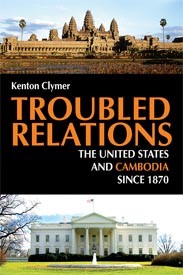America's Cambodia shame
 Book Review
Book ReviewTroubled Relations: The United States and Cambodia since 1870 by Kenton Clymer (published by Northern Illinois University Press, June 2007, 254 pages).
I don’t want to sound overly naïve but this book was a real eye-opener for me as to the frankly disgraceful way in which successive United States’ administrations have treated third-world countries, in this particular case, Cambodia. This is an abridged and updated version of Kenton Clymer’s definitive history of the relationship between the two countries. It was originally published as two volumes in 2004 by Routledge, and this revised edition comes courtesy of Northern Illinois University Press, who graciously sent me a copy for review and where Clymer is a Professor of History.
What I found particularly deplorable was the utter contempt with which senior US diplomats treated Cambodia and its people throughout the period under the microscope. It wasn’t just one or two administrations, it was all of them. For most of us, the connection between the two countries came strongly into focus during the Vietnam War when US planes mercilessly bombed perceived enemy strongholds in Cambodia. The attacks led to Cambodia’s involvement in the war and to civil war, from which the Khmer Rouge emerged victorious. And we all know that what followed tragically saw nearly one third of the country’s population die under the Khmer Rouge’s genocidal regime.
I found the whole book fascinating, with Clymer’s background research and revelations providing a story that made me angrier as I turned each new page. In fact, this book should be compulsory reading for any American visiting Cambodia today, so they are made aware of their own country’s shambolic and disgraceful attitude towards this increasingly popular tourist destination. The fact that the United States, alongwith my own country, the United Kingdom, supported the continuation of the Khmer Rouge seat at the United Nations for so long, for purely anti-Soviet and Vietnamese political reasons, even though they were both fully aware of the genocide perpetrated by its leadership and cadre, makes my blood boil even now. And its not abaited today, with some individuals still seeking regime change by blocking vital funding.
America’s first interest in Cambodia stemmed from intrepid travelers like Frank Vincent Jr, Jacob Conner, Helen Churchill Candee, Harry A Franck and Robert Casey who all wrote about their adventures in Cambodia before the missionaries moved in, albeit with limited success. It was the period after the 2nd World War that America began to take more interest in this gentle, faraway land as the threat of communism reared its head in Asia and the on-off love affair with Cambodia’s mercurial leader, Norodom Sihanouk, began. In the 60s, the South Vietnamese and their US allies made frequent incursions into Cambodian territory and American apologies for the loss of Cambodian lives were hollow. The inglorious end to American involvement, firstly in Vietnam and then the final evacuation from Cambodia in April 1975, so graphically portrayed in the film, The Killing Fields, rankled with the US administration and formulated their embarrassing anti-Cambodia stance throughout the 80s.
As I finished reading Kenton Clymer’s book, I felt that the United States’ relationship with Cambodia was one which, if I was an American, I would feel deeply ashamed.
Link: Amazon.


1 Comments:
Reposted comments:
Brian Stenson said...
Hi Andy,
does this book add anything new to what Shawcross and Kamm had to say in their excellent books?
Also I have read Cambodia Now by Karen Coates (recommended by you) and I feel that this book gives as good a picture of Cambodia at present as you are likely to get.
Regards
Brian
8:48 PM
------------------------------------
Andy said...
hi Brian,
i havent read Shawcross for so long and didn't read Kamm's book. However, this book is a study of the complete relationship between the two countries and as such gives a good overall picture, though it is pretty sketchy up til the 2nd World War (probably because relations were sketchy too). I enjoyed it as it gave me the whole picture rather than the snippets I'd read elsewhere.
As for Karen's Cambodia Now book, I agree totally with your comment that its THE best book of its type that portrays Cambodia's current situation through the lives of individuals.
Regards, Andy
9:07 AM
------------------------------------
Post a Comment
<< Home